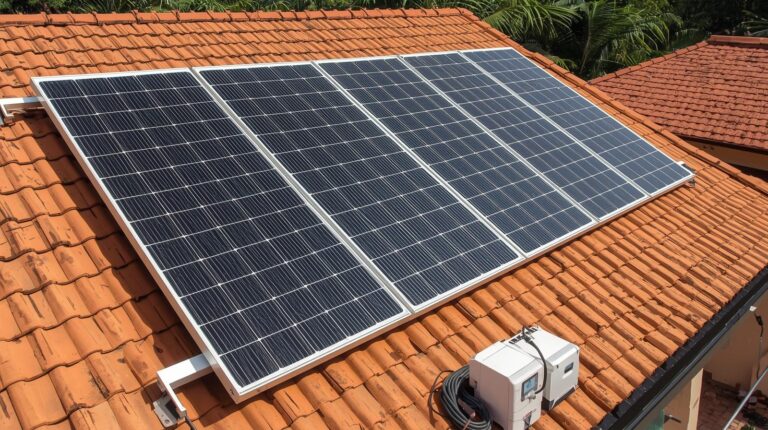As we explore the forefront of solar power generation technology, these seven most promising innovations offer transformative potential across various sectors. From the integration of solar windows that not only provide transparency but also harness energy, to the strategic placement of high-altitude solar balloons that capture sunlight from above the clouds, these advancements underscore a significant leap in efficiency and application.
In addition, the development of solar paint and thin-film solar panels pushes the boundaries of conventional solar applications, making it possible to imagine a future where nearly any surface can generate power. As we consider these innovations, the implications for future energy sustainability and environmental impact are profound and warrant further exploration.
Key Takeaways
- Solar windows technology integrates photovoltaic cells into glass, transforming surfaces into energy producers.
- High-altitude solar balloons capture sunlight above clouds, boosting energy efficiency in remote locations.
- Revolutionary solar paint allows diverse surfaces to generate electricity, enhancing energy accessibility.
- Space-based solar developments aim to collect sunlight in orbit, offering a vast energy supply without atmospheric limits.
- Floating solar farms utilize water bodies to improve panel cooling and efficiency, conserving land resources.
Solar Windows Technology
Solar Windows Technology represents a transformative advancement in sustainable building design, integrating photovoltaic cells into transparent window coatings to harness solar energy.
This technology employs a photovoltaic glaze, which includes minuscule solar cells, enabling the windows to generate electricity while maintaining transparency and aesthetic appeal.
With an estimated 5-7 billion square meters of glass surfaces available in the U.S. alone, the potential for this technology to contribute considerably to net zero climate goals is immense.
These innovative windows can be installed at room temperature, which simplifies the process of retrofitting existing structures, making solar windows a versatile solution in urban environments.
Additionally, the integration of smart grid technology enhances the efficiency and application of solar windows by optimizing energy distribution and usage.
Companies like Solar Window Technologies and Ubiquitous Energy are at the forefront, redefining how buildings can integrate solar energy generation seamlessly into their design.
High-Altitude Solar Balloons
Elevating the capabilities of solar technology, high-altitude solar balloons represent a groundbreaking approach to energy harvesting. By transporting solar panels to altitudes of approximately 12.5 miles, these balloons can capture sunlight with markedly greater efficiency than traditional ground-based systems.
This method not only enhances energy production but also opens up new avenues for solar energy harvesting in remote areas where conventional energy infrastructure may be lacking. Integrating these innovations, such as solar power technology, is vital for achieving a sustainable future that protects our planet.
Research conducted by the University of Tokyo has shed light on this innovative approach, highlighting its potential to transform energy generation. However, the deployment of high-altitude solar balloons must navigate considerable challenges:
- Cost and Component Efficiency: While utilizing cost-effective components, the overall economic viability needs continual assessment against the performance benefits.
- Aviation Regulation Compliance: Ensuring that these balloons do not interfere with air traffic is essential, necessitating close coordination with aviation authorities.
- Safety and Reliability: Addressing the risks associated with malfunctions, which could have implications for both the technology and the surrounding environment, is vital.
As solar power technology evolves, these balloons could be pivotal in realizing the broader adoption of solar energy, especially in underserved regions.
Their development and implementation demand meticulous planning and regulatory consideration to fully harness their potential while ensuring safety and compliance.
Advancements in Hairy Solar Panels
Harnessing the power of nanotechnology, advancements in hairy solar panels mark a significant leap forward in the field of renewable energy. These panels utilize innovative light-absorbing nanowires, capable of absorbing up to 96% of solar light, a stark improvement over traditional silicon panels. This enhancement in energy harvesting efficiency is not just a numerical upgrade but a transformative shift in how solar energy can be utilized across various applications.
The inclusion of solar tracking systems in these panels can further enhance their efficiency, by adjusting to the sun’s movement throughout the day for peak light absorption.
The structural flexibility provided by nanowires allows these panels to integrate into environments where rigid panels are impractical, opening up a plethora of innovative applications. From curved surfaces on architecture to mobile devices, the potential for integration of hairy solar panels is vast and varied. This flexibility, coupled with superior energy absorption capabilities, underscores a significant advancement in material science within the solar industry.
However, durability challenges persist. Ensuring that these panels can withstand environmental factors over long periods remains a focal point of ongoing research. Scientists are dedicated to refining the technology to maintain both efficiency and structural integrity, paving the way for reliable, next-generation solar energy applications that could revolutionize energy capture and utilization.
Innovations in Thin-Film Solar
As the quest for more efficient and adaptable solar solutions continues, thin-film solar technology emerges as a pivotal innovation, considerably enhancing the versatility and affordability of solar energy systems. This technology, leveraging lightweight solar films manufactured in rolls, not only reduces manufacturing costs but also simplifies installation processes compared to traditional solar panels.
With the ability to integrate into roofing materials and building structures, thin-film panels boost aesthetic value while providing robust energy generation capabilities without requiring additional space. Additionally, the integration of advanced sensor technology in these panels helps in optimizing their performance by adapting to varying sunlight conditions, further enhancing their efficiency.
Key innovations in thin-film solar technology include:
- Increased Efficiency: Recent advancements have seen efficiency rates soar above 20%, making these panels competitive with traditional silicon-based options.
- Flexible Applications: These flexible solar panels can conform to various surfaces, making them ideal for energy harvesting in unique or constrained environments, including portable devices.
- Reduced Environmental Impact: The production process for thin-film solar panels generally consumes less energy and fewer resources, thereby mitigating the environmental impacts associated with their manufacture.
This confluence of reduced costs, enhanced aesthetic integration, and environmental consideration positions thin-film solar technology as a significant player in the future of energy solutions, tailoring solar power to a broader range of applications and settings.
Emerging Floating Solar Farms
Emerging floating solar farms represent a transformative development in renewable energy technology, offering the dual benefits of conserving land and enhancing electricity generation. By deploying solar panels on water bodies, this innovative approach not only leverages underutilized aquatic surfaces but also aligns with global sustainability goals. Notable installations such as the Heroldsberg Solar Farm in California and Dezhou Dingzhuang in China underscore the viability and scalability of floating solar systems.
These systems benefit from the cooling effects of water, which help maintain ideal operating conditions and improve efficiency. This attribute is essential because it directly impacts the energy output, making floating solar a potent competitor to traditional power sources.
Additionally, the installed capacity of floating solar is projected to exceed 10 gigawatts by 2025, indicating robust growth in the global market. The integration of solar systems into existing power grids is becoming more streamlined, enhancing the feasibility and scalability of renewable installations like floating solar farms.
Moreover, floating solar farms play a significant role in water conservation. By covering large water surfaces, they reduce evaporation, consequently preserving crucial water resources while generating renewable energy.
This dual functionality exemplifies how floating solar farms not only address the need for clean power but also contribute to essential environmental conservation efforts, marking a significant step forward in the renewable energy landscape.
Revolutionary Solar Paint
Building on the innovative spirit of floating solar farms, another groundbreaking technology reshaping the renewable energy sector is solar paint. This transformative product harnesses energy generation from unconventional surfaces, enabling buildings to produce power without traditional solar panels.
Solar paint encompasses several cutting-edge types, including hydrogen-generating paint, photovoltaic paint with quantum dots, and sprayable perovskite paint.
The adoption of solar paint promotes energy accessibility, heralding a new era where renewable energy solutions are not only viable but integral to sustainable building practices. The technology is poised to democratize energy generation, providing affordable options for consumers and contributing notably to energy independence.
- Versatility and Application: Can be applied on various surfaces, transforming any building into a power generator.
- Technological Advancements: Focus on enhancing efficiency and durability to withstand diverse environmental conditions.
- Sustainability Impact: Supports the shift to sustainable practices by integrating renewable energy into everyday materials.
Researchers are diligently working to refine the innovative technology behind solar paint, ensuring its practicality for widespread use. As solar paint evolves, it promises to be a pivotal component in the global pursuit of renewable and accessible energy solutions.
Space-Based Solar Developments
The concept of space-based solar developments represents a transformative leap in renewable energy technology. By deploying solar satellites in orbit, this approach harnesses sunlight without atmospheric interference, dramatically increasing the efficiency of energy collection compared to terrestrial solar technology.
These satellites have the potential to generate power equivalent to multiple nuclear plants and deliver continuous, reliable solar power to meet urban and global energy demands.
However, the path to realizing space-based solar energy is fraught with challenges. The initial investment costs for developing and deploying this technology are estimated at $1 trillion. Additionally, there are significant regulatory and public safety concerns related to the transmission of energy back to Earth.
Despite these hurdles, the promise of clean, abundant energy from solar satellites makes this a compelling area of research and development, potentially revolutionizing how we meet our energy needs.
| Challenge | Current Focus | Potential Impact |
|---|---|---|
| High Initial Costs | Developing cost-effective prototypes | Reducing deployment expenses |
| Regulatory and Safety | Establishing safe energy transmission protocols | Ensuring public and environmental safety |
| Continuous Energy Supply | Achieving efficient space-based energy collection | Meeting substantial shares of energy demands |
This table underscores the critical areas of focus and their implications for advancing space-based solar power technologies.
Conclusion
To sum up, the latest advancements in solar power technology represent a significant leap toward sustainable energy solutions. Technologies such as solar windows, high-altitude solar balloons, and innovative applications of nanowires in solar panels enhance the efficiency and versatility of solar energy collection.
Additionally, the development of thin-film solar, floating solar farms, and solar paint underscore the industry’s commitment to expanding the usability and environmental benefits of solar power, marking a pivotal shift in renewable energy strategies.




